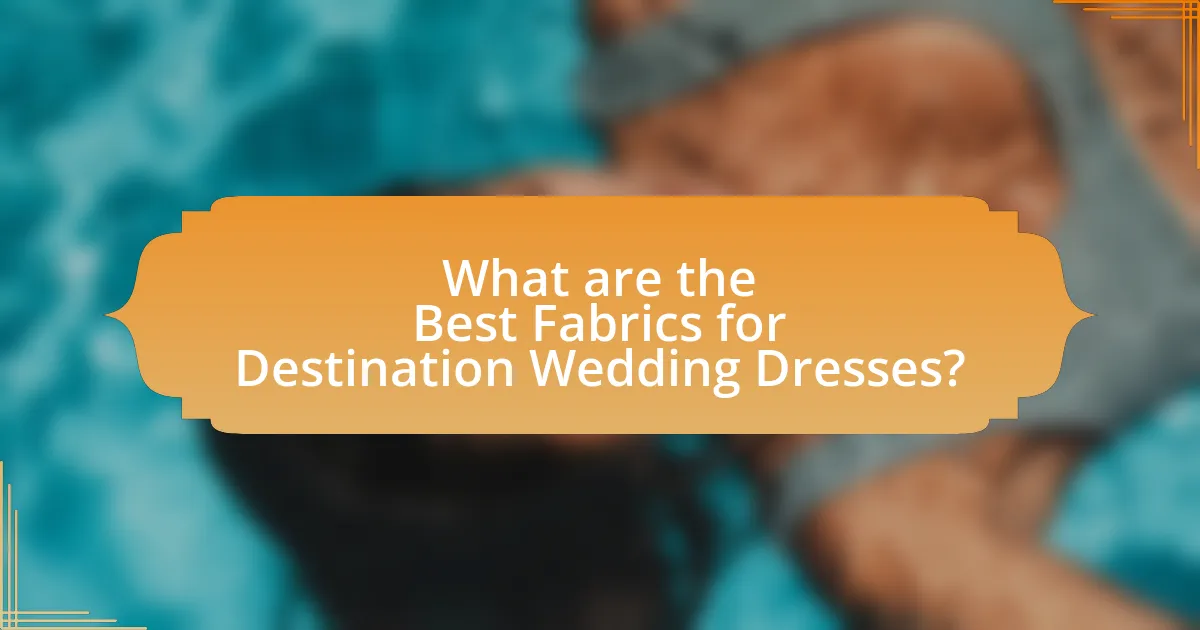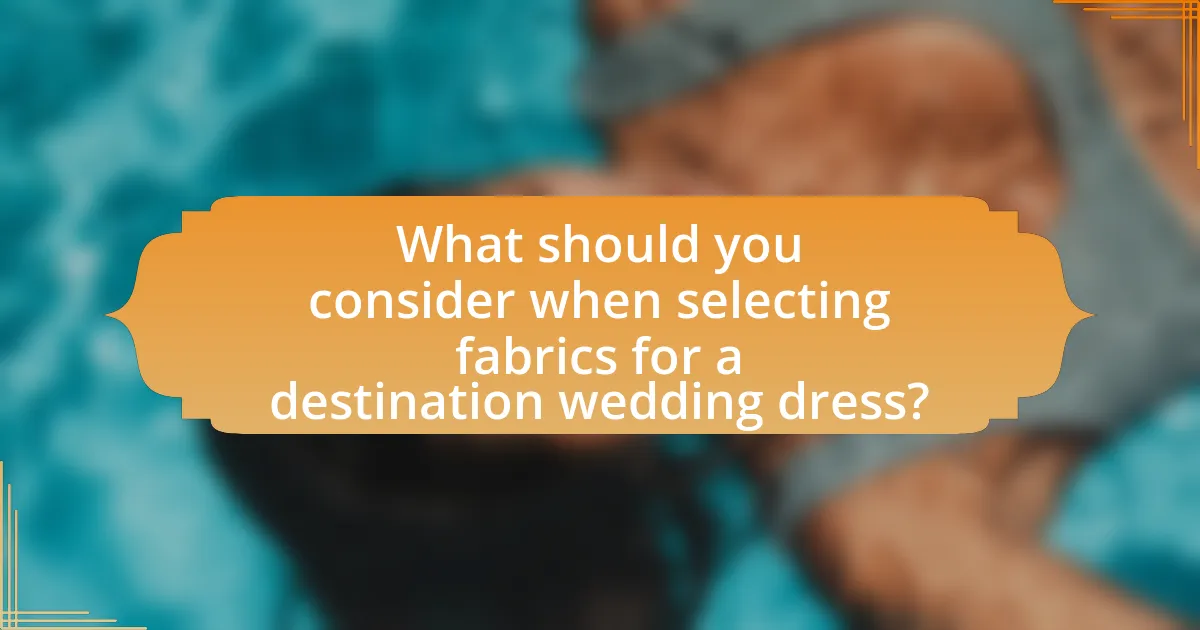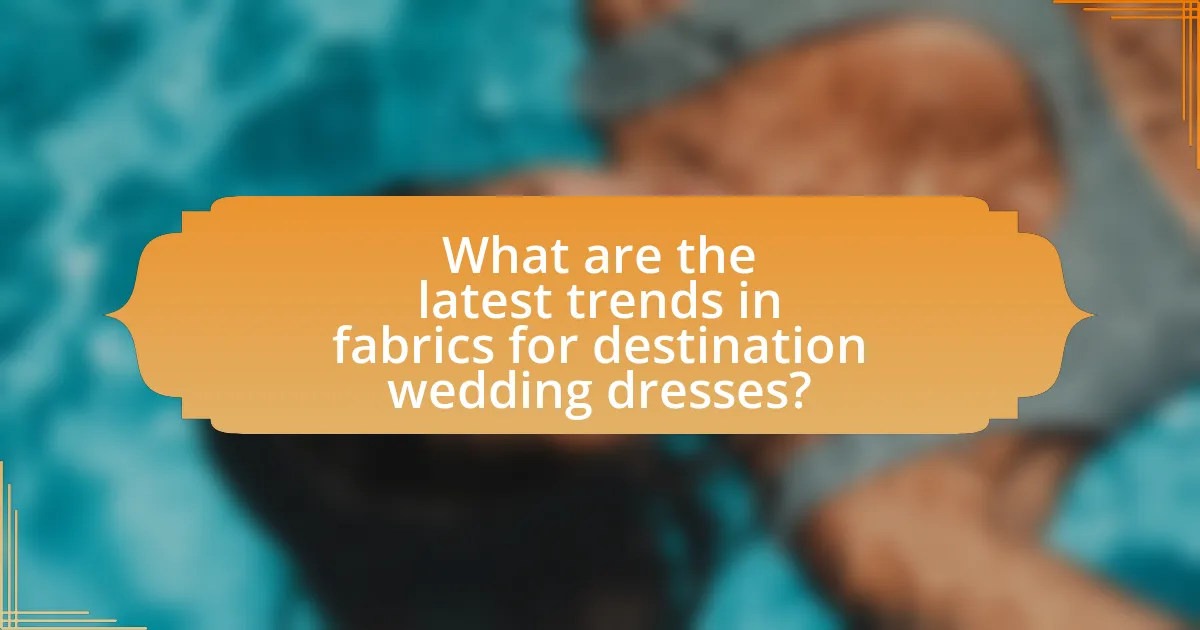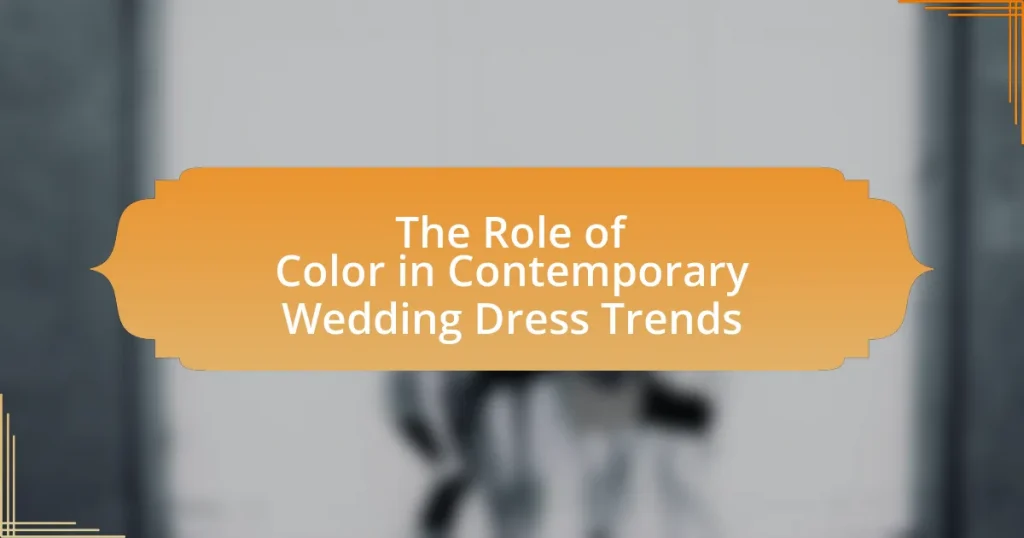The article focuses on the best fabrics for destination wedding dresses, emphasizing lightweight materials such as chiffon, georgette, and silk, which are ideal for warm climates. It discusses the importance of fabric choice in relation to comfort, breathability, and aesthetic appeal, particularly in varying climates. The article also explores how different fabrics influence the overall style of wedding dresses, the impact of climate on fabric selection, and the latest trends in sustainable fabrics. Additionally, practical considerations for fabric maintenance and care during travel are highlighted, providing brides with essential tips for selecting the perfect fabric for their special day.

What are the Best Fabrics for Destination Wedding Dresses?
The best fabrics for destination wedding dresses include lightweight materials such as chiffon, georgette, and silk. These fabrics are ideal because they are breathable and flowy, making them comfortable for warm climates often associated with destination weddings. Chiffon, for instance, is known for its soft texture and ability to drape elegantly, while silk offers a luxurious feel and sheen. Georgette is also a popular choice due to its slightly heavier weight, which provides structure without sacrificing comfort. These fabrics not only enhance the aesthetic appeal of the dress but also ensure that the bride remains comfortable throughout the event.
Why is fabric choice important for destination wedding dresses?
Fabric choice is crucial for destination wedding dresses because it directly impacts comfort, breathability, and the overall aesthetic suited for various climates. Lightweight fabrics like chiffon and silk are ideal for warm, tropical locations as they allow for airflow and ease of movement, preventing overheating. Conversely, heavier fabrics may be unsuitable in such environments, leading to discomfort. Additionally, the right fabric enhances the dress’s drape and silhouette, ensuring it looks elegant in photographs and during the ceremony. Therefore, selecting the appropriate fabric is essential for both the bride’s comfort and the visual appeal of the wedding attire in a destination setting.
How does climate influence fabric selection for destination weddings?
Climate significantly influences fabric selection for destination weddings by dictating the breathability, weight, and moisture-wicking properties of the materials used. For instance, in hot and humid climates, lightweight fabrics such as chiffon, linen, and cotton are preferred due to their ability to allow air circulation and keep the wearer cool. Conversely, in cooler climates, heavier fabrics like satin or velvet may be chosen for their warmth and structure. Additionally, fabrics that resist wrinkling, such as polyester blends, are often favored for travel convenience, ensuring that garments maintain their appearance despite varying environmental conditions.
What role does comfort play in choosing fabrics for destination wedding dresses?
Comfort is a crucial factor in selecting fabrics for destination wedding dresses, as it directly impacts the wearer’s experience throughout the event. Fabrics that are lightweight, breathable, and flexible, such as chiffon, silk, and cotton blends, enhance comfort, especially in warm climates typical of destination weddings. Research indicates that breathable materials help regulate body temperature, reducing discomfort during prolonged wear. For instance, a study published in the Journal of Textile Science highlights that natural fibers like cotton and linen allow for better air circulation compared to synthetic options, making them preferable for outdoor settings. Thus, prioritizing comfort in fabric choice ensures that the bride can enjoy her special day without being hindered by her attire.
What types of fabrics are commonly used for destination wedding dresses?
Destination wedding dresses commonly utilize lightweight and breathable fabrics such as chiffon, silk, and lace. Chiffon is favored for its airy quality, making it ideal for warm climates, while silk offers a luxurious feel and drapes beautifully. Lace adds intricate detailing and texture, enhancing the overall aesthetic. These fabrics are chosen for their comfort and elegance, ensuring that brides feel both stylish and at ease during their special day in various locations.
What are the characteristics of lightweight fabrics suitable for warm climates?
Lightweight fabrics suitable for warm climates are characterized by their breathability, moisture-wicking properties, and ability to dry quickly. These fabrics, such as cotton, linen, and rayon, allow air circulation, which helps regulate body temperature and keeps the wearer cool. Additionally, they often have a loose weave or a lightweight structure that enhances comfort in high temperatures. For instance, cotton is known for its softness and breathability, while linen has natural moisture-wicking abilities, making it ideal for hot weather.
How do breathable fabrics enhance the comfort of a wedding dress?
Breathable fabrics enhance the comfort of a wedding dress by allowing air circulation, which helps regulate body temperature and reduce moisture buildup. This is particularly important during long wedding ceremonies and receptions, where comfort can be compromised by heat and humidity. Fabrics such as chiffon, linen, and cotton are known for their breathability, enabling the wearer to feel cooler and more comfortable throughout the event. Studies have shown that breathable materials can significantly improve comfort levels in warm conditions, making them ideal for destination weddings in tropical climates.
How do different fabrics affect the overall style of a destination wedding dress?
Different fabrics significantly influence the overall style of a destination wedding dress by determining its drape, texture, and visual appeal. For instance, lightweight fabrics like chiffon and organza create a flowing silhouette that is ideal for beach or outdoor settings, enhancing a romantic and ethereal look. In contrast, heavier fabrics such as satin or taffeta provide structure and formality, making them suitable for more traditional or elegant venues. Additionally, fabrics with intricate lace details can add a vintage or bohemian touch, aligning with the relaxed atmosphere often sought in destination weddings. The choice of fabric not only affects the dress’s aesthetic but also its comfort and suitability for varying climates, which is crucial for destination weddings.
What styles are best suited for chiffon and lace fabrics?
Chiffon and lace fabrics are best suited for flowing, romantic styles such as A-line gowns, empire waist dresses, and bohemian-inspired silhouettes. These styles leverage the lightweight and airy nature of chiffon, which drapes beautifully, while lace adds intricate detailing and texture. A-line gowns create a flattering shape that enhances movement, and empire waist designs emphasize the bust while allowing for a relaxed fit, making them ideal for destination weddings. Bohemian styles often incorporate layers of chiffon and lace, creating a whimsical and ethereal look that is popular for outdoor ceremonies.
How do satin and silk contribute to a more formal look?
Satin and silk enhance a more formal look due to their luxurious textures and elegant drape. Satin, with its glossy surface, reflects light beautifully, creating a sophisticated appearance that is often associated with formal attire. Silk, known for its softness and natural sheen, adds an element of refinement and opulence, making garments appear more upscale. Both fabrics have historical ties to formal wear; for instance, silk has been used in royal garments for centuries, reinforcing its association with elegance and high status. The combination of these qualities makes satin and silk ideal choices for destination wedding dresses, elevating the overall aesthetic to match the significance of the occasion.

What should you consider when selecting fabrics for a destination wedding dress?
When selecting fabrics for a destination wedding dress, consider the climate and location of the wedding. Lightweight and breathable fabrics such as chiffon, linen, and cotton are ideal for warm climates, as they allow for comfort and ease of movement. In contrast, heavier fabrics like satin or taffeta may be suitable for cooler destinations. Additionally, consider the fabric’s ability to resist wrinkling, as destination weddings often involve travel; fabrics like jersey or silk blends tend to hold their shape better. Finally, the fabric’s drape and flow should complement the dress style, ensuring it enhances the overall aesthetic while providing comfort throughout the event.
How does the wedding location impact fabric choice?
The wedding location significantly impacts fabric choice by dictating the climate and setting, which influence comfort and style. For instance, a beach wedding typically requires lightweight, breathable fabrics like chiffon or linen to accommodate warm temperatures and humidity, while a winter wedding in a colder climate may necessitate heavier materials such as satin or velvet for warmth. Additionally, the aesthetic of the location can guide fabric selection; rustic venues may pair well with textured fabrics like lace, while elegant ballrooms might call for luxurious silks. This alignment between fabric and location ensures that the bride remains comfortable and visually cohesive with her surroundings.
What fabrics are ideal for beach weddings?
Lightweight and breathable fabrics are ideal for beach weddings. Fabrics such as chiffon, linen, and cotton are particularly suitable due to their ability to keep the wearer cool and comfortable in warm, humid conditions. Chiffon is known for its flowy nature, which enhances movement and elegance, while linen offers a relaxed, natural look that is perfect for a beach setting. Cotton is also a great choice as it is soft, breathable, and easy to care for, making it practical for outdoor ceremonies. These fabrics not only provide comfort but also complement the casual and romantic atmosphere of a beach wedding.
Which materials work best for garden or outdoor ceremonies?
Natural fabrics such as cotton, linen, and chiffon work best for garden or outdoor ceremonies. These materials are lightweight, breathable, and comfortable, making them ideal for warm weather and outdoor settings. Cotton is known for its softness and versatility, while linen offers a relaxed, textured look that complements natural surroundings. Chiffon, being sheer and flowy, adds an elegant touch without being overly heavy. These fabrics not only enhance comfort but also allow for ease of movement, which is essential for outdoor events.
What are the practical considerations for fabric selection?
Practical considerations for fabric selection include the climate, drape, weight, and care requirements of the fabric. For destination weddings, the climate is crucial; lightweight fabrics like chiffon or linen are ideal for warm weather, while heavier fabrics like satin may be suitable for cooler climates. The drape of the fabric affects how the dress falls and moves, with flowy materials enhancing comfort and elegance. Additionally, the weight of the fabric impacts portability, as lighter fabrics are easier to pack and carry. Finally, care requirements are important; fabrics that are easy to clean and maintain are preferable for travel.
How does the weight of the fabric affect dress mobility?
The weight of the fabric significantly affects dress mobility, as lighter fabrics generally allow for greater ease of movement. For instance, materials like chiffon and organza are lightweight and flowy, enabling the wearer to move freely, dance, and navigate various terrains comfortably. In contrast, heavier fabrics such as satin or taffeta can restrict movement due to their density and structure, making it more challenging to walk or engage in activities. Studies in textile science indicate that fabric weight directly correlates with drape and flexibility, influencing how a dress behaves during wear.
What maintenance requirements should be considered for different fabrics?
Different fabrics require specific maintenance to ensure their longevity and appearance. For example, silk should be dry cleaned to prevent damage, while cotton can typically be machine washed and tumble dried. Linen requires gentle washing and should be air-dried to avoid shrinkage. Polyester is durable and can withstand machine washing, but it should be washed in cold water to maintain its color. Wool needs to be hand washed or dry cleaned to avoid felting. Each fabric’s unique properties dictate these maintenance requirements, ensuring that the garment remains in optimal condition for events like destination weddings.

What are the latest trends in fabrics for destination wedding dresses?
The latest trends in fabrics for destination wedding dresses include lightweight materials such as chiffon, organza, and lace, which provide comfort and breathability in warm climates. These fabrics are favored for their ability to flow elegantly and create a romantic aesthetic, making them ideal for beach or outdoor settings. Additionally, sustainable fabrics like organic cotton and recycled polyester are gaining popularity, reflecting a growing trend towards eco-conscious fashion in the wedding industry. This shift is supported by the increasing demand for environmentally friendly options among modern brides.
How are sustainable fabrics influencing wedding dress choices?
Sustainable fabrics are significantly influencing wedding dress choices by increasing demand for eco-friendly materials among brides. As awareness of environmental issues grows, many brides are opting for dresses made from organic cotton, hemp, and recycled polyester, which reduce the carbon footprint associated with traditional fabrics. A survey by The Knot in 2021 indicated that 30% of couples prioritized sustainability in their wedding planning, reflecting a shift towards more responsible consumer behavior. This trend is prompting designers to innovate and offer a wider range of stylish, sustainable options, thereby reshaping the wedding dress market.
What eco-friendly options are available for brides?
Eco-friendly options available for brides include sustainable fabrics such as organic cotton, hemp, and Tencel, which are produced with minimal environmental impact. These materials are biodegradable and often sourced from renewable resources, reducing the carbon footprint associated with traditional wedding dress fabrics. Additionally, brides can opt for vintage or second-hand dresses, which promote recycling and reduce waste. According to a report by the Ellen MacArthur Foundation, the fashion industry is responsible for 10% of global carbon emissions, highlighting the importance of choosing eco-friendly alternatives.
How do innovative fabric technologies enhance wedding dress designs?
Innovative fabric technologies enhance wedding dress designs by providing improved functionality, comfort, and aesthetic appeal. For instance, moisture-wicking fabrics keep brides cool and dry, while lightweight materials like chiffon and organza allow for elegant draping and movement. Additionally, advancements in fabric treatments, such as stain resistance and UV protection, ensure that dresses maintain their beauty throughout the event. These technologies not only elevate the overall design but also cater to the practical needs of brides, making them more suitable for various wedding environments, including destination weddings.
What are the most popular fabric combinations for destination wedding dresses?
The most popular fabric combinations for destination wedding dresses include chiffon and lace, silk and tulle, and cotton and organza. Chiffon and lace are favored for their lightweight and breathable qualities, making them ideal for warm climates. Silk and tulle provide a luxurious feel while allowing for elegant layering, suitable for both beach and garden settings. Cotton and organza offer a casual yet refined look, perfect for outdoor ceremonies. These combinations are chosen for their ability to balance comfort and style, ensuring brides feel beautiful and at ease on their special day.
How can layering different fabrics create unique styles?
Layering different fabrics can create unique styles by combining textures, colors, and weights to enhance visual interest and depth in an outfit. For instance, a lightweight chiffon layered over a structured satin can create a soft, ethereal look while maintaining form. This technique allows designers to play with contrasts; for example, pairing a delicate lace with a heavier fabric like taffeta can add dimension and sophistication. Additionally, layering can facilitate versatility, enabling a single outfit to transition from day to night by simply adjusting the layers. Fashion experts note that this approach not only showcases creativity but also allows for personalization, as individuals can mix and match fabrics to reflect their personal style.
What are the benefits of mixing textures in wedding dress design?
Mixing textures in wedding dress design enhances visual interest and depth, creating a more dynamic and unique garment. By combining different materials, such as lace, satin, and tulle, designers can achieve a contrast that highlights various design elements, making the dress more visually appealing. This technique allows for the play of light and shadow, which can enhance the overall aesthetic and draw attention to specific features of the dress. Additionally, mixing textures can improve the overall comfort and fit, as different fabrics can provide varying levels of breathability and structure, essential for destination weddings where climate may vary.
What tips can help brides choose the perfect fabric for their destination wedding dress?
Brides should prioritize lightweight and breathable fabrics for their destination wedding dress to ensure comfort in warm climates. Fabrics such as chiffon, georgette, and lightweight silk are ideal as they allow for airflow and movement, making them suitable for outdoor settings. Additionally, considering the dress’s structure is important; for example, flowy silhouettes work well with softer fabrics, while structured designs may require stiffer materials like taffeta. Choosing fabrics that resist wrinkling, such as jersey or polyester blends, can also enhance the dress’s appearance throughout the event. Ultimately, selecting the right fabric involves balancing comfort, style, and the specific climate of the destination.
How can brides test fabric comfort before making a decision?
Brides can test fabric comfort by feeling the material against their skin and wearing samples for a short period. This tactile approach allows brides to assess the softness, breathability, and overall comfort of the fabric. Additionally, they can check for any irritation or itching by moving around in the fabric, simulating the experience of wearing the dress throughout the day. Research indicates that natural fibers like cotton and silk tend to be more breathable and comfortable compared to synthetic options, which can help brides make informed decisions based on their comfort preferences.
What should brides keep in mind regarding fabric care during travel?
Brides should prioritize the choice of fabric and packing methods to ensure proper care during travel. Lightweight and wrinkle-resistant fabrics, such as polyester blends or chiffon, are ideal as they maintain their appearance despite being packed tightly. Additionally, brides should use garment bags to protect their dresses from dirt and damage, and consider hanging the dress upon arrival to minimize creasing. According to bridal experts, proper fabric care during travel can significantly reduce the need for extensive ironing or steaming, preserving the dress’s integrity for the wedding day.



